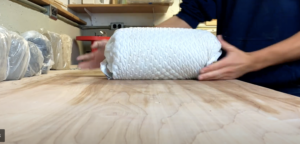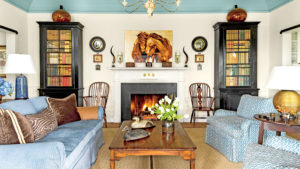Storing Pottery Clay In Cool Dry Cooler
Proper storage of pottery clay is essential to maintain its workability and prevent it from drying out prematurely. Pottery clay, which can be in various forms such as soft, leather-hard, or bone-dry, needs to be stored in a way that prevents excessive evaporation of moisture, which can cause the clay to become too stiff to work with or even crack. To ensure your clay stays in optimal condition, several key precautions and storage practices must be followed.
Cover When Not In Use
First, it’s crucial to keep the clay moist or covered, as exposure to air will cause the moisture content to gradually decrease, leading to drying out. The most effective method of storing clay is by wrapping it in plastic, which creates a sealed environment that traps moisture. For large blocks of clay, artists often use heavy-duty plastic wrap or trash bags. These materials keep air from penetrating and allow the clay to retain its moisture. Smaller portions of clay can be stored in plastic bags, tightly sealed to ensure that no air reaches the material. Another precaution is to use damp towels or cloths to wrap the clay before sealing it in plastic. The moisture from the towel helps maintain an appropriate humidity level, preventing the clay from drying too quickly.
Optimal Storage Temperatures
To better understand the optimal storage area, a comparison chart with different types of coolers or storage environments can be used:

When analyzing a coolers compared, the temperature is typically consistent and controlled, with insulation that helps retain moisture. However, it’s important to make sure there’s ventilation, as humidity levels can become too high, leading to mold growth. In contrast, a simple plastic-wrapped block of clay at room temperature is an easier and more accessible option, though it requires more frequent monitoring to ensure the clay doesn’t dry out. For longer storage, an insulated storage bin offers moderate protection, but it’s necessary to check periodically for any signs of dehydration.
Space & Scale Considerations
 Ultimately, where most artists store their clay depends on the scale of their operations and available space. Many opt for cool storage rooms, basements, or climate-controlled areas where the temperature and humidity can be kept stable. A dedicated space or even a small section of the studio with proper containers ensures that the clay remains fresh and ready for use. By understanding the needs of pottery clay and choosing the best storage method, artists can ensure their materials are always in optimal condition for their creative processes.
Ultimately, where most artists store their clay depends on the scale of their operations and available space. Many opt for cool storage rooms, basements, or climate-controlled areas where the temperature and humidity can be kept stable. A dedicated space or even a small section of the studio with proper containers ensures that the clay remains fresh and ready for use. By understanding the needs of pottery clay and choosing the best storage method, artists can ensure their materials are always in optimal condition for their creative processes.
 Many artists, designers, and preservationists understand the delicate balance between modernization and historical preservation. They approach the restoration of old buildings with great care, using techniques that respect the original craftsmanship while improving the durability and energy efficiency of these elements. In some cases, restoring wood windows—rather than replacing them—helps maintain the character of the building, especially in properties that are listed on historic registries or in districts where certain building codes and guidelines are in place. Repairing rather than replacing also ensures that the craftsmanship of the era is respected, and the materials used are authentic to the original construction. This is crucial for maintaining the aesthetic integrity of the space, as the warm, natural texture of wood adds a sense of timelessness and authenticity to a historical building.
Many artists, designers, and preservationists understand the delicate balance between modernization and historical preservation. They approach the restoration of old buildings with great care, using techniques that respect the original craftsmanship while improving the durability and energy efficiency of these elements. In some cases, restoring wood windows—rather than replacing them—helps maintain the character of the building, especially in properties that are listed on historic registries or in districts where certain building codes and guidelines are in place. Repairing rather than replacing also ensures that the craftsmanship of the era is respected, and the materials used are authentic to the original construction. This is crucial for maintaining the aesthetic integrity of the space, as the warm, natural texture of wood adds a sense of timelessness and authenticity to a historical building. In addition to
In addition to 
 Home is where the heart is. It is a place where you feel at ease. A businessman can ditch his suit and tie, parents can chase rowdy toddlers without being judged, and more. Home is also the one place where you can walk around in comfortable clothes and decorate based on your personal style. Thankfully, your options are unlimited because of the new contemporary furnishings that are available to you. They allow you to celebrate modernism or stick to somewhat traditional, without being the same things you parents had in their home.
Home is where the heart is. It is a place where you feel at ease. A businessman can ditch his suit and tie, parents can chase rowdy toddlers without being judged, and more. Home is also the one place where you can walk around in comfortable clothes and decorate based on your personal style. Thankfully, your options are unlimited because of the new contemporary furnishings that are available to you. They allow you to celebrate modernism or stick to somewhat traditional, without being the same things you parents had in their home. Modernism is a way of design and architecture that has strong lines, but also is very conceptual. It is a lot like a mosaic in which you get the idea of what is there, but it is interrupted by something at the same time. It may confuse the mind, especially if you are looking at modern art, but also makes you want to see and understand the hidden meaning of the paintings. When you look at modernized furniture, you will notice sleek lines, bold colors, and other features that make it stand out. The same is true for architectural styles. There are a lot of themed buildings and homes that look more space aged than most expect. One example of this is the Chemosphere, which is located in the Hollywood Hills. Other subtler, modern architecture may include square homes that resemble boxes that are located on cliff so that you may look out a window and feel like you are flying.
Modernism is a way of design and architecture that has strong lines, but also is very conceptual. It is a lot like a mosaic in which you get the idea of what is there, but it is interrupted by something at the same time. It may confuse the mind, especially if you are looking at modern art, but also makes you want to see and understand the hidden meaning of the paintings. When you look at modernized furniture, you will notice sleek lines, bold colors, and other features that make it stand out. The same is true for architectural styles. There are a lot of themed buildings and homes that look more space aged than most expect. One example of this is the Chemosphere, which is located in the Hollywood Hills. Other subtler, modern architecture may include square homes that resemble boxes that are located on cliff so that you may look out a window and feel like you are flying. Embracing modern over traditional is somewhat easy for some people. For others, it is hard to give up the traditional idea completely to embrace the more modern side of art and decor. For those who are not completely ready to give up tradition, there are still plenty of home decor ideas. You could choose to keep the traditional furnishings, but add modern art work and statues to the room or have sleek furniture combined with rustic wall art. The choice is yours and you can do anything you want if you prefer to not go completely modern or traditional. In fact, mixing the two very unique styles will further emphasize that it is your home and you have decorated in a way that makes you the most comfortable. When you are mixing modern and traditional, you should choose one type of decor style as the rooms main feature, but then bust it up with a little of the other. Either way, it is an endless amount of possibilities for those who are not ready to go full on traditional or modern.
Embracing modern over traditional is somewhat easy for some people. For others, it is hard to give up the traditional idea completely to embrace the more modern side of art and decor. For those who are not completely ready to give up tradition, there are still plenty of home decor ideas. You could choose to keep the traditional furnishings, but add modern art work and statues to the room or have sleek furniture combined with rustic wall art. The choice is yours and you can do anything you want if you prefer to not go completely modern or traditional. In fact, mixing the two very unique styles will further emphasize that it is your home and you have decorated in a way that makes you the most comfortable. When you are mixing modern and traditional, you should choose one type of decor style as the rooms main feature, but then bust it up with a little of the other. Either way, it is an endless amount of possibilities for those who are not ready to go full on traditional or modern. Home decorating is not a chore to be dreaded. The truth is, you can do anything you want, and it will still be impressive. Even if outsiders do not agree with your choices, it does not matter as long as you are content. A decorator can help you find the happy medium between outstanding and comfortable if you do not feel that you are up for the task alone. They can help you create a home that you feel is worthy of you kicking off your shoes in.
Home decorating is not a chore to be dreaded. The truth is, you can do anything you want, and it will still be impressive. Even if outsiders do not agree with your choices, it does not matter as long as you are content. A decorator can help you find the happy medium between outstanding and comfortable if you do not feel that you are up for the task alone. They can help you create a home that you feel is worthy of you kicking off your shoes in.